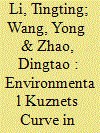|
|
|
Sort Order |
|
|
|
Items / Page
|
|
|
|
|
|
|
| Srl | Item |
| 1 |
ID:
150888


|
|
|
|
|
| Summary/Abstract |
This paper applies a panel of 28 provinces of China from 1996 to 2012 to study the impacts of economic development, energy consumption, trade openness, and urbanization on the carbon dioxide, waste water, and waste solid emissions. By estimating a dynamic panel model with the system Generalized Method of Moments (GMM) estimator and an autoregressive distributed lag (ARDL) model with alternative panel estimators, respectively, we find that the Environmental Kuznets Curve (EKC) hypothesis is well supported for all three major pollutant emissions in China across different models and estimation methods. Our study also confirms positive effects of energy consumption on various pollutant emissions. In addition, we find some evidence that trade and urbanization may deteriorate environmental quality in the long run, albeit not in the short run. From policy perspective, our estimation results bode well for Chinese government's goal of capping greenhouse emissions by 2030 as outlined in the recent China-US climate accord, while containing energy consumption and harm effects from expanding trade and urbanization remains some environmental challenges that China faces.
|
|
|
|
|
|
|
|
|
|
|
|
|
|
|
|
| 2 |
ID:
166996


|
|
|
|
|
| Summary/Abstract |
Thermal power plants are considered to be the culprit of various pollutants. In China, a country dominated by coal-fired power generation, the problem is more serious. Regulators must use capacity control of coal-fired power generation as a key policy tool for emission reduction. This paper was concerned about the environmental effect of changes in thermal power capacity utilization on pollutants emissions in China. Under the econometric strategy of panel smoothing transformation regression (PSTR) model, the switching regimes and paths of seven pollutants emissions to thermal power capacity utilization were evaluated with the transition variables of power generation and electricity consumption, respectively. The three statistics, LM test, LMF and pseudo-LRT, unanimously verify the necessity of nonlinearity. In addition to CO2 emissions whose transition function presents U-shaped feature both in the models with power generation and electricity consumption as transition variable, the other pollutants such as SO2, NOX and so on generally exhibit quasi S-shaped change trend. The interaction term of installed capacity and average annual operating hours of thermal power plants introduced to reflect the interactive environmental effect of thermal power capacity utilization on pollutants emissions, appear similarity in most pollutants. However, the negative coefficients of the transition functions for interactive environmental effect imply that the policymakers reduce pollution by defusing capacity, which needs to be supplemented by setting reasonable warning line for operating hours of thermal power.
|
|
|
|
|
|
|
|
|
|
|
|
|
|
|
|
|
|
|
|
|